|
You now have your horse (or tiger) primed a pure white with jewels and eyes
masked off and you can not put off painting it any longer. You must decide
what color to paint it! If you have planned in advance what colors you will
use or if you are doing a restoration the next step is a piece of cake. If,
however, you have no idea in mind or you have not sanded or carved "in color"
you are now faced with a ghostly monster!
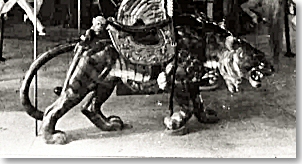
Sneaky the Tiger, 1909
|
In a restoration
you can prepare by extracting paint chips from the original colors and create
a blueprint for the authentic colors. Even these original colors can be
mixed brighter or in a more modern tint or shade if desired. Your color
choices should take into account the effect of time, exposure and oxidation of
the original paint colors.
I have become more of a realist when dealing with original paint colors. We
tend to forget that the carousels were created to generate income. If no one
picked a particular horse to ride due to its "colors" it was repainted during
the off-season. Or the colors were often changed to reflect the popular colors
of the day...even the dreaded olive green and orange of the 70's.
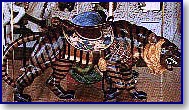
Repainted to be similar to the original paint
|
Perhaps we are
so intent in restoring an "original color" we end up restoring a "bad day" for
the painter. He may have been faced with deadlines or shipping dates and
simply didn't have time to change something that just didn't work. Or maybe he
changed the color by putting on a new layer of paint before it left the
factory. We have thus restored the wrong color! The marvelous carvings of the
early carousel animals carried the work, the beauty is still there. The
overall impact of the entire carousel was still there, but an individual horse
may not be able to stand alone in its color composition.
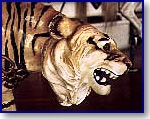
The tiger as it appeared in the beginning years of
its realistic painting.
|
Another idea is
to research the time period in which your carved piece was created. If it is
done in a carving style of the 1895 period it should reflect the popular hues
of that period. Sources for this information can be found in your library
under home furnishing, architecture, and fashion. Many wallpaper and paint
companies provide patterns and color collections for a certain historical time
period. Maybe the new carving is to be placed in your living room and can
reflect the colors that you like and have chosen to live with. A simple piece
of fabric may be the beginning of your color choices.
Be prepared to make changes in your plan. Sometimes what works in your head
or on paper just won't work when painted on the carving. Change it . . . it is only
paint! Let the horse evolve. If you don't like the color now you probably
aren't going to like it later!
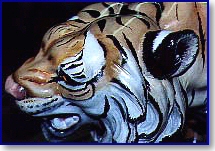
All striped up, and a friendlier nose
|
The carousel
animals carved in America between the 1870's and the 1890's were often very
simple in carving style but painted with glorious patterns and plaids. This
painting style often reflected folk patterns, techniques and tole painting of
the homelands of the immigrant carvers and painters.
During the next period,
the trend was more toward carving style and embellishments that were often of
sculptural quality with detail lines carved into the surface. The factory
painter simply had to color within the lines. The next stage was the
mass-produced animal which again was more simple and stylized in carving
style. This was due to the difficulty in casting the intricate carving
details. Once again the painter was allowed to be more creative in his
technique.
It is the painter's job to make the carver look good! Even if they are the
same person. If the carousel animal has beautifully carved muscles, the
painter can enhance them with shading. If the muscles are lacking, the painter
can shade to enhance what isn't there. If the carver had a bad day and forgot
to carve a stem or a piece of strap, the painter can paint it in for him. The
painter can emphasize the eyes, bring out he shape of a flower, or save the
composition with detail, shadow and pattern. They are a team! The painter
should treat the carving as a blank canvas and compose his work even though
his canvas is now three dimensional.
My example is
the comparison of the original paint job on the 1909 Spokane Looff carousel's
Sneaky Tiger. The original painting technique used gives the appearance that
the stripes were painted on with a ruler. (photo 1) It is definitely not an
example of Charles Looff's earlier works which are known for their realistic
body painting, marvelous colors and the use of stencils and folk painting.
This was definitely a rushed or poor factory painted job. The tiger was carved
between 1905 and 1909, the delivery date of the carousel to Spokane. It is
branded on the belly "Riverside Rhode Island, a practice which was not begun
until 1905.
The next photo (photo 2) shows how the tiger had changed through the years.
It was a good start but still there was room for improvement. It has elaborate
carvings and a resident Spider monkey on its back. No original paint was left
and no records were kept of the original colors when it was stripped over 20
years ago. We had to begin a "new history" on the animal. I was also asked to
do something that would make it less frightening as younger children would
often refuse to ride him.
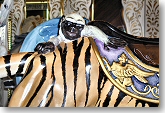
The Lemur Monkey
|
The tiger had
gone through various metamorphous stages endeavoring to look more realistic.
Even though it had been stripped there were layers of blue, red, purple, black
and yellow on his trappings. My first step was to do some research for the
more realistic body painting. This began with books from the library and
visits to a local zoo.
There is nothing like spending an afternoon with a
Bengal tiger, staring eye to eye, to give you the feel for his color, his
majesty of movement and to realize how well the carving had been done in
capturing his power. It would have been a travesty to restore those original
jail-house stripes on such a magnificently carved creature. Watercolor studies
were done as I continued my research to get a feel for the final painting.
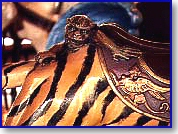
The Spider Monkey, sometimes frightening to small children
|
I soon
discovered that the tiger was the most endangered species in the world. Little
details were important, such as no two tigers are striped alike but they all
have a white triangular patch on the top of their black ears. Perhaps if this
one sneaking tiger was painted well it could spark a love for the entire
species. This could lead to the saving of the species or at least, some
empathy for their plight. In my research I also found that the
Lemur monkey was indigenous to the same territory of the Bengal tigers
in Malaysia. Not only that, but the Lemur is a friendlier looking monkey
than the Spider monkey!
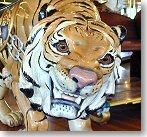
Sneaky with his kitty nose
|
The final two photos show the results. The soft copper chain (unrealistic)
has been replaced with a heavier chain of iron, to hold the power of the large
cat. The trappings are the rich purple with shades of blue, the color of
royalty. The Zalar style Sphinx carvings are done in a rich antique gold. The
inside strap is painted to look like the deep purple of Thai silk highlighted
with gold threads.
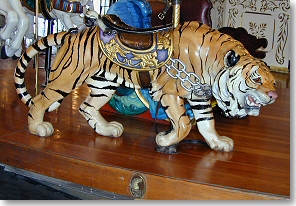
Sneaky the Tiger with his new stripes!
|
There are subtle touches to soften and overcome his fearsome appearance. A
soft pink nose although mature tigers' noses are black. This gives him a
"kitty" appearance. The lovely long eyelashes soften the face, making it more
feminine and friendlier. Every child who rides "Sneaky" now loves the little
white monkey on the back and often places a carousel ring on the tiger's tooth
after a loving pat on its nose. Sneaky now takes the youngest rider off to
the lands of Aladdin, and as Tony always says "it's just G-r-r-r-r-e-a-t!"
|
Bette Largent is a professional carousel horse restoration artist from
Washington State, and the author of
Paint The Ponies,
a guide for those who are interested in learning the art of painting
carousel figures.
Click
Here
for information on ordering her book.
|
|
